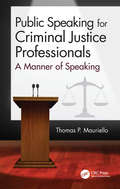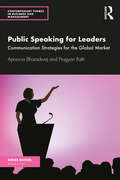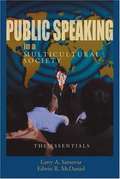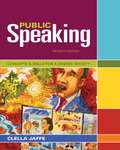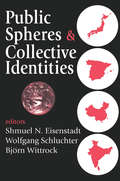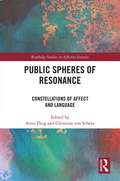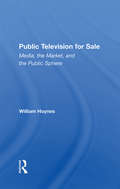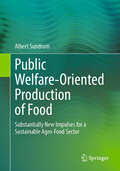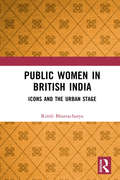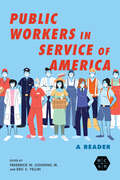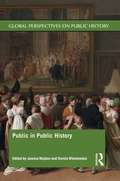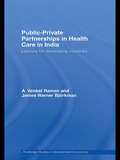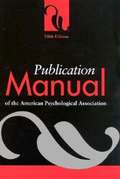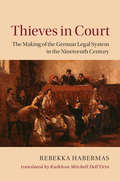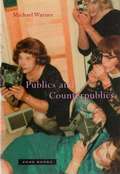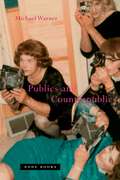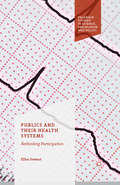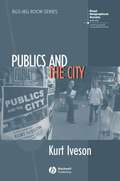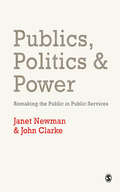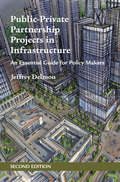- Table View
- List View
Public Speaking for Criminal Justice Professionals: A Manner of Speaking
by Thomas P MaurielloPublic Speaking for Criminal Justice Professionals: A Manner of Speaking is a one-of-a-kind public speaking guide specifically written for criminal justice professionals, written by a criminal justice professional. Author Thomas Mauriello has worked his entire professional career both as a practitioner and as an educator in the fields of criminal justice and forensic science. This book outlines the public speaking skills he has learned, used, and taught to thousands of criminal justice, forensic science, security, and counterintelligence professionals over the years. The book can either be read from cover-to-cover—to fine tune the reader’s existing oral communication skills—or read in a modular fashion, as a reference guide to focus on certain skills and techniques. A list of over 55 proven, effective presentation tools will be listed, discussed, and demonstrated throughout the book—using illustrated criminal justice and forensic sciences topic examples. Contrary to popular believe, simply knowing your subject or being an expert in the subject does not guarantee a successful presentation. Aristotle, who many recognize as the Father of Public Speaking and Forensic Debate, said it best when he declared, "It is not enough to know what to say, one must know how to say it." This guide focuses on technique and the recognition that a speaker must have of both the subject and the listener. The purpose is to improve readers' skill level and ability to engage and, thereby, inform the listener. Whether preparing to speak to one person, or one thousand people, Public Speaking for Criminal Justice Professionals provides specific techniques for professionals to speaking with confidence, and present effective engaging presentations.
Public Speaking for Leaders: Communication Strategies for the Global Market (Contemporary Themes in Business and Management)
by Pragyan Rath Apoorva BharadwajThis book studies the art of public speaking as oration instead of just ornamentation. It repositions public speaking as a fundamental business leadership act and a solution-enabling and problem-solving communication approach. Drawing on in-depth case studies, it considers various situations that a managerial leader encounters and delivers speech solutions as strategic manoeuvres for attaining desired targets. The volume: Deals with public speaking exclusively from a business perspective; Produces a workable manual of managerial public speaking that introduces the concept of oration as Or-action (oratory that leads to desired action); Presents a variegated analysis of speech texts from history, politics, fiction, social media, film industry, platform content, and business-product presentations; Customizes speeches into unique speech clusters where readers can readily find the type of speech texts they require for their own specific content development. The first of its kind, this book will be a key text for entrepreneurs, corporate managers, academic practitioners, and executives. It will also be of interest to students and researchers of behavioural economics, rhetoric, strategy, communication studies, business communication, fiction theory, generation studies, and virtual reality studies.
Public Speaking in a Multicultural Society: The Essentials
by Larry A. Samovar Edwin R. McdanielThis book demonstrates the many ways in which culture influences the public speaking process in contemporary settings.
Public Speaking: Concepts and Skills for a Diverse Society (7th Edition)
by Clella JaffePUBLIC SPEAKING is a culturally informed book that never loses sight of its fundamental purpose: to train students to be effective public speakers and listeners in a world filled with monumental cultural, political, and technological changes. It applies 2,500-year-old principles with up-to-date research into concepts, skills, theories, applications, and critical thinking proficiencies essential for listening and speaking in today's world. Its discussions of classic public speaking topics are all grounded in an awareness of the impact of cultural nuances--ranging from gender differences to co-cultures within the United States to the traditions of other nations. This provides speakers with a heightened awareness of and sensitivity to the audience.
Public Spectacles in Roman and Late Antique Palestine
by Zeev WeissPublic Spectacles in Roman and Late Antique Palestine introduces readers to the panoply of public entertainment that flourished in Palestine from the first century BCE to the sixth century CE. Drawing on a trove of original archaeological and textual evidence, Zeev Weiss reconstructs an ancient world where Romans, Jews, and Christians intermixed amid a heady brew of shouts, roars, and applause to watch a variety of typically pagan spectacles. Ancient Roman society reveled in many such spectacles--dramatic performances, chariot races, athletic competitions, and gladiatorial combats--that required elaborate public venues, often maintained at great expense. Wishing to ingratiate himself with Rome, Herod the Great built theaters, amphitheaters, and hippodromes to bring these forms of entertainment to Palestine. Weiss explores how the indigenous Jewish and Christian populations responded, as both spectators and performers, to these cultural imports. Perhaps predictably, the reactions of rabbinic and clerical elites did not differ greatly. But their dire warnings to shun pagan entertainment did little to dampen the popularity of these events. Herod's ambitious building projects left a lasting imprint on the region. His dream of transforming Palestine into a Roman enclave succeeded far beyond his rule, with games and spectacles continuing into the fifth century CE. By then, however, public entertainment in Palestine had become a cultural institution in decline, ultimately disappearing during Justinian's reign in the sixth century.
Public Spheres and Collective Identities
by Walter LippmannToday it is assumed that we understand contemporary nationalism and nation-building. Researchers rarely consider the very different traditions from which such state-building emerged. Instead, there is almost too much discussion of the "global village," with its supposed uniformity and inevitable trajectories. We need to view modernity as something other than a single condition with a preordained future. New visions of a modern civilization are emerging throughout the world, calliing for a far-reaching appraisal of the older visions of modernization.Following Eisenstadt's and Schluchter's introduction, Bjorn Wittrock explores the varieties and transitions of early modern societies, noting that only by looking at societies' collective identities and their modes of mediating in the public sphere can the distinguishing factors between modernity be appreciated. Sheldon Pollock discusses the use of vernacular language in India through its literary culture and polity, 1000-1500. Sanjay Subrahmanyam, sums up major developments in the recent historiography of South Asia from 1400 to 1750. David L. Howell focuses on the boundaries of the early modern Japanese state, including its political boundaries and the boundaries of collective identity and social status. Mary Elizabeth Berry examines public life in authoritarian Japan. Frederic Wakeman, Jr. probes the boundaries of the political game and how they were affected by the increased political centralization that developed after the disorder of the Ming-Qing transition during the seventeenth century. Alexander Woodside discusses territorial order and collective-identity tensions in Confucian Asia. Bernhard Giesen argues that the French Enlightenment can be described as an extension of absolutist court culture. Finally essay, Victor Perez-Diaz examines the state and public sphere in Spain during the Ancient Regime contrasting two ideal types of states--a "nomocratic" model and a "teleocratic" model.This volume addresses cultural and political practices not only from outside the European and American spheres but also over long periods of time in which the internal dynamics of other civilizations become visible. Its broad-ranging use of empirical materials enables us to think comparatively and historically about the ways in which different modernities took shape.
Public Spheres of Resonance: Constellations of Affect and Language (Routledge Studies in Affective Societies)
by Christian Von Scheve Anne FleigTo understand the profound changes in the modes of public political debate over the past decade, this volume develops a new conception of public spheres as spaces of resonance emerging from the power of language to affect and to ascribe and instill collective emotion. Political discourse is no longer confined to traditional media, but increasingly takes place in fragmented and digital public spheres. At the same time, the modes of political engagement have changed: discourse is said to increasingly rely on strategies of emotionalization and to be deeply affective at its core. This book meticulously shows how public spheres are rooted in the emotional, bodily, and affective dimensions of language, and how language – in its capacity to affect and to be affected – produces those dynamics of affective resonance that characterize contemporary forms of political debate. It brings together scholars from the humanities and social sciences and focuses on two fields of inquiry: publics, politics, and media in Part I, and language and artistic inquiry in Part II. The thirteen chapters provide a balanced composition of theoretical and methodological considerations, focusing on highly illustrative case studies and on different artistic practices. The volume is an indispensable source for researchers and postgraduate students in cultural studies, literary studies, sociology, and political science. It likewise appeals to practitioners seeking to develop an in-depth understanding of affect in contemporary political debate.
Public Television For Sale: Media, The Market, And The Public Sphere
by William HoynesPublic television is uniquely positioned in our country to contribute to the invigoration of democratic public life because, ostensibly, it is neither driven by the market nor dominated by the state. In this comprehensive analysis of the forces that shape our public television system, sociologist William Hoynes finds that public television increasi
Public Welfare-Oriented Production of Food: Substantially New Impulses for a Sustainable Agro-Food Sector
by Albert SundrumFood is a means of life. The way it is produced affects us all. Largely unnoticed by the public, a system of the agricultural and food industry has developed in recent decades that supplies us with an abundance of food at excessively low prices. However, the undesirable side effects and external costs of this system have long been ignored. Enormous environmental and climate impacts, loss of biodiversity, animal welfare problems and the continuing death of farms only inadequately describe the true extent of the harmful effects. In the interests of the public welfare, these can no longer be tolerated. However, the complexity of the issues and the diversity of vested interests stand in the way of simple solutions. This professional book provides a comprehensive systemic analysis from very different perspectives and explains how this development has come about. It shows what fundamental changes are needed in all areas in order to find a way out of the destructive pursuit ofcost minimisation through evidence-based quality production. Professionals in the agricultural and food industry and the scientific disciplines involved, including veterinary medicine, as well as decision-makers in political institutions, professional associations and NGOs can use this knowledge to redesign the food sector for the future.
Public Women in British India: Icons and the Urban Stage
by Rimli BhattacharyaThis book foregrounds the subjectivity of ‘acting women’ amidst violent debates on femininity and education, livelihood and labour, sexuality and marriage. It looks at the emergence of the stage actress as an artist and an ideological construct at critical phases of performance practice in British India. The focus here is on Calcutta, considered the ‘second city of the Empire’ and a nodal point in global trade circuits. Each chapter offers new ways of conceptualising the actress as a professional, a colonial subject, simultaneously the other and the model of the ‘new woman’. An underlying motif is the playing out of the idea of spiritual salvation, redemption and modernity. Analysing the dynamics behind stagecraft and spectacle, the study highlights the politics of demarcation and exclusion of social roles. It presents rich archival work from diverse sources, many translated for the first time. This book makes a distinctive contribution in intertwining performance studies with literary history and art practices within a cross-cultural framework. Interdisciplinary and innovative, it will appeal to scholars and researchers in South Asian theatre and performance studies, history and gender studies.
Public Workers in Service of America: A Reader (Working Class in American History)
by Eileen Boris Jon Shelton Katherine Turk Amy Zanoni William Powell Jones Cathleen D Cahill Joseph E Slater Francis RyanFrom white-collar executives to mail carriers, public workers meet the needs of the entire nation. Frederick W. Gooding Jr. and Eric S. Yellin edit a collection of new research on this understudied workforce. Part One begins in the late nineteenth- and early twentieth century to explore how questions of race, class, and gender shaped public workers, their workplaces, and their place in American democracy. In Part Two, essayists examine race and gender discrimination while revealing the subtle contemporary forms of marginalization that keep Black men and Black and white women underpaid and overlooked for promotion. The historic labor actions detailed in Part Three illuminate how city employees organized not only for better pay and working conditions but to seek recognition from city officials, the public, and the national labor movement. Part Four focuses on nurses and teachers to address the thorny question of whether certain groups deserve premium pay for their irreplaceable work and sacrifices or if serving the greater good is a reward unto itself. Contributors: Eileen Boris, Cathleen D. Cahill, Frederick W. Gooding Jr., William P. Jones, Francis Ryan, Jon Shelton, Joseph E. Slater, Katherine Turk, Eric S. Yellin, and Amy Zanoni
Public and Private Welfare in Modern Europe: Productive Entanglements (Routledge Open History)
by Fabio GiomiSince the 1980s, neoliberals have openly contested the idea that the state should protect the socio-economic well-being of its citizens, making ‘privatization’ their mantra. Yet, as historians and social scientists have shown, welfare has always been a ‘mixed economy’, wherein private and public actors dynamically interacted, collaborating or competing with each other in the provision of welfare services. This book will be of interest to students, scholars and practitioners of welfare by developing three innovative approaches. Firstly, it illuminates the productive nature of public/private entanglements. Far from amounting to a zero-sum game, the interactions between the two sectors have changed over time what welfare encompasses, its contents and targets, often engendering the creation of new fields of intervention. Secondly, this book departs from a well-established tradition of comparison between Western nation-states by using and mixing various scales of analysis (local, national, international and global) and by covering case studies from Spain to Poland and France to Greece in the nineteenth and twentieth centuries. Thirdly, this book goes beyond state centrism in welfare studies by bringing back a host of public and private actors, from municipalities to international organizations, from older charities to modern NGOs.
Public in Public History (Global Perspectives on Public History)
by Joanna Wojdon Dorota WiśniewskaPublic in Public History presents international research on the role of the public in public history: the ways people perceive, respond to and influence history-related institutions, events, services and products that deal with the past. The book addresses theoretical reflections on the public, or multiple publics, and their role in public history, and empirical analyses of the publics’ active responses to and impact on existing forms of public history. Special attention is also paid to digital public history, which facilitates the double role of the public—as both recipient and creator of public history. With a multinational author team, the book is based on various national, but also international, experiences and academic traditions; each chapter goes beyond national cases to look transnationally. The narratives built around their cases deal with issues such as arranging a museum exhibition, managing a history-related website, analyzing readers’ comments or involving non-professional public as oral history researchers. With sections focusing on research, commemorations, museums and the digital world, this is the perfect collection for anyone interested in what the public means in public history.
Public-Private Partnership Projects in Infrastructure
by Jeffrey DelmonInvestment in infrastructure is critical to economic growth, quality of life, poverty reduction, access to education, healthcare, and achieving many of the goals of a robust economy. But infrastructure is difficult for the public sector to get right. Public-private partnerships (PPPs) can help; they provide more efficient procurement, focus on consumer satisfaction and life cycle maintenance, and provide new sources of investment, in particular through limited recourse debt. But PPPs present challenges of their own. This book provides a practical guide to PPPs for policy makers and strategists, showing how governments can enable and encourage PPPs, providing a step-by-step analysis of the development of PPP projects, and explaining how PPP financing works, what PPP contractual structures look like, and how PPP risk allocation works in practice. It includes specific discussion of each infrastructure sector, with a focus on the strategic and policy issues essential for successful development of infrastructure through PPPs.
Public-Private Partnerships in Health Care in India: Lessons for developing countries (Routledge Studies in Development Economics)
by A. Venkat Raman James Warner BjörkmanPublic-private partnerships are increasingly advocated to alleviate deficiencies in the public health system as well as to reduce economic stress on those who seek services from an expensive, burgeoning and unregulated private health sector. Focusing on India, this book examines how the private sector in developing countries is tapped to deliver health care services to poor and under-served sections of society through collaborative arrangements with the government. Having emerged as a key reform initiative, aspects of public-private partnership are examined such as the genesis of private sector partnerships, the ways in which the private sector is encouraged to deliver public health services, and the models and formats that make such partnerships possible. Based on in-depth case studies from different states of India and drawing on experiences in other countries, the authors analyse challenges, opportunities and benefits of implementing public-private partnerships and explore whether partnership with the private sector can be designed to deliver health care services to the poor as well as the consequences for beneficiaries. This book will be of interest to scholars of public policy and development administration, health policy and development economics as well as South Asian Studies.
Publication Manual of the American Psychological Association (5th edition)
by American Psychological AssociationIn 1999 the APA Publications and Communications Board authorized work to begin on this fifth edition of the Publication Manual.
Publication Manual of the American Psychological Association (6th Edition)
by American Psychological AssociationThe style manual of choice for writers, editors, students, and educators in the social and behavioral sciences, this updated "Publication Manual" provides invaluable guidance on all aspects of the writing process, from the ethics of authorship to the word choice that best reduces bias.
Publications of the German Historical Institute: Thieves in Court
by Rebekka Habermas Kathleen Mitchell Dell’OrtoFrom the seemingly insignificant theft of some bread and a dozen apples in nineteenth century rural Germany, to the high courts and modern-day property laws, this English-language translation of Habermas' Diebe vor Gericht explores how everyday incidents of petty stealing and the ordinary people involved in these cases came to shape the current legal system. Habermas draws from an unusual cache of archival documents of theft cases, tracing the evolution and practice of the legal system of Germany through the nineteenth century. This close reading, relying on approaches of legal anthropology, challenges long-standing narratives of legal development, state building, and modern notions of the rule of law. Ideal for legal historians and scholars of modern German and nineteenth-century European history, this innovative volume steps outside the classic narratives of legal history and gives an insight into the interconnectedness of social, legal and criminal history.
Publicity and the Canadian State
by Kirsten KozolankaPublicity pervades our political and public culture, but little has been written that critically examines the basis of the modern Canadian "publicity state." This collection is the first to focus on the central themes in the state's relationship with publicity practices and the "permanent campaign," the constant search by politicians and their strategists for popular consent. Central to this political popularity contest are publicity tools borrowed from private enterprise, turning political parties into sound bites and party members into consumers.Publicity and the Canadian State is the first sustained study of the contemporary practices of political communication, focusing holistically on the tools of the publicity state and their ideological underpinnings: advertising, public opinion research, marketing, branding, image consulting, and media and information management, as well as related topics such as election law and finance, privacy, think-tank lobbying, and non-election communication campaigns.Bringing together contemporary Canadian analysis by scholars in a number of fields, this collection will be a welcome new resource for academics, public relations and policy professionals, and government communicators at all levels.
Publics and Counterpublics
by Michael WarnerMichael Warner addresses the question: What is a public? According to Warner, the idea of a public is one of the central fictions of modern life. Publics have powerful implications for how our social world takes shape, and much of modern life involves struggles over the nature of publics and their interrelations. The idea of a public contains ambiguities, even contradictions. As it is extended to new contexts, politics, and media, its meaning changes in ways that can be difficult to uncover. Combining historical analysis, theoretical reflection, and extensive case studies, Warner shows how the idea of a public can reframe our understanding of contemporary literary works and politics and of our social world in general.
Publics and Counterpublics
by Michael WarnerPublics and Counterpublics revolves around a central question: What is a public? The idea of a public is a cultural form, a kind of practical fiction, present in the modern world in a way that is very different from other or earlier societies. Like the idea of rights, or nations, or markets, it can now seem universal. But it has not always been so. Publics exist only by virtue of their imagining. They are a kind of fiction that has taken on life, and very potent life at that.Publics have some regular properties as a form, with powerful implications for the way our social world takes shape; but much of modern life involves struggles over the nature of publics and their interrelation. There are ambiguities, even contradictions in the idea of a public. As it is extended to new contexts and media, new polities and rhetorics, its meaning can be seen to change, in ways that we have scarcely begun to appreciate.By combining historical analysis, theoretical reflection, and extended case studies, Publics and Counterpublics shows how the idea of a public works as a formal device in modern culture and traces its implications for contemporary life. Michael Warner offers a revisionist account at the junction of two intellectual traditions with which he has been associated: public-sphere theory and queer theory. To public-sphere theory, this book brings a new emphasis on cultural forms, and a new focus on the dynamics of counterpublics. To queer theory, it brings a new way of seeing how queer culture (among other examples) is shaped by the counterpublic environment.
Publics and Their Health Systems: Rethinking Participation (Palgrave Studies in Science, Knowledge and Policy)
by Ellen StewartDrawing on a detailed case study of Scotland's National Health Service, this book argues that debates about citizen participation in health systems are disproportionately dominated by techniques of invited participation. A 'system's-eye' perspective, while often well-intentioned, has blinded us to other standpoints for understanding the complex relationship between publics and their health systems. Publics and Their Health Systems takes a 'citizen's-eye' perspective, exploring not only conventional invited participation, but also the realms of representative democracy, contentious protest politics, and the micro-level tactics used by individual citizens in their encounters with health services. The book highlights more oppositional dynamics than those which characterise much invited participation, and argues that understanding these is a crucial step towards a more inclusive and democratic health system.
Publics and the City (RGS-IBG Book Series #80)
by Kurt IvesonPublics and the City investigates struggles over the making of urban publics, considering how the production, management and regulation of ‘public spaces’ has emerged as a problem for both urban politics and urban theory. Advances a new framework for considering the diverse spatialities of publicness in relation to the city Argues that a city’s contribution to the making of publics goes beyond the provision of places for public gathering Examines a series of detailed case studies Looks at the relationship between urbanism, public spheres, and democracy
Publics, Politics and Power: Remaking the Public in Public Services
by John H. Clarke Janet E. NewmanPublicness appears to be in decline or retreat in the face of markets, consumerism and individualism. Yet questions of public participation, public governance and the reform of public services are at the top of the political agenda in many countries.<P><P> Publics, Politics and Power offers an innovative analysis of the changing fortunes of publicness. The book<P> * Explores the emergence of new forms, sites and practices of publicness and the implications for public services.<P> * Examines the remaking of the public in the context of new formations of the nation, where issues of migration, diversity and faith challenge traditional forms of solidarity and citizenship.<P> * Traces the emergence of hybrid organizational forms and new strategies for governing publics and public services.<P> * Assesses some of the ways in which the public domain is being recast around notions of civil society, community, and populist participatory politics.<P> Chapters include vignettes illustrating the book's core concepts, making this a useful teaching resource and valuable reading for students of public management, public and social policy, sociology and cultural studies, and for those working in public services.<P> Janet Newman is a Professor of Social Policy at the Open University, and Director of the Publics Research Programme within the Centre for Citizenship, Identities and Governance. John Clarke is a Professor of Social Policy at the Open University. His research has centred on conflicts over the future of welfare states, public services and citizenship in the UK and elsewhere.
Public–Private Partnership Projects in Infrastructure: An Essential Guide for Policy Makers
by Delmon JeffreyInvestment in infrastructure is critical to economic growth, quality of life, poverty reduction, access to education, healthcare, and achieving many of the goals of a robust economy. But infrastructure is difficult for the public sector to get right. Public-private partnerships (PPPs) can help; they provide more efficient procurement, focus on consumer satisfaction and life cycle maintenance, and provide new sources of investment, in particular through limited recourse debt. But PPPs present challenges of their own. This book provides a practical guide to PPPs for policy makers and strategists, showing how governments can enable and encourage PPPs, providing a step-by-step analysis of the development of PPP projects, and explaining how PPP financing works, what PPP contractual structures look like, and how PPP risk allocation works in practice. It includes specific discussion of each infrastructure sector, with a focus on the strategic and policy issues essential for successful development of infrastructure through PPPs.
